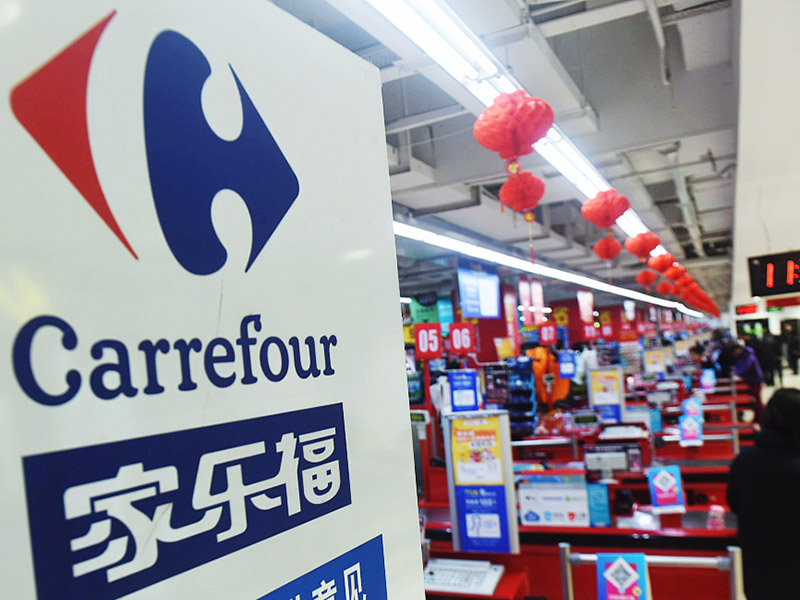
- [email protected]
- +86 21 5386 0380


The rise and fall (and rise again?) of Carrefour in China
- March 16, 2023
- Carrefour in China , Carrefour's strategy in China , The future of Carrefour in China
In 2022, Carrefour was the 8 th most popular supermarket chain in China, with a revenue of 27.3 billion USD. At the beginning of 2022, the French giant had more than 200 stores across China. However, in Q1 of the same year, it registered the definitive closure of more than 24 stores. Carrefour crisis in China accelerated in 2019, after the acquisition of the company’s stakes by the Chinese brand Suning, which now holds 80% of Carrefour’s retail operations in China. Fierce competition is also damaging the company’s sales in China, the superstore is progressively losing ground to other Chinese supermarket companies.
The history of Carrefour in China and how the company made its own name in the market
Carrefour entered the Chinese market in 1995 through an alliance with Shanghai Hualian , an electrical appliance company. At that time, the Chinese government had imposed restrictions on the retail industry that hindered the expansion of foreign companies in China. However, Carrefour managed to gain popularity in its early years of operation, as it faced less competition from other foreign retailers who were affected by the government regulations.

The Chinese name of the company, “家乐福”, means “family, happiness and fortune”. The company focused on 1 st tier cities such as Beijing and Shanghai, where it offered quality products at low and convenient prices . One of the main marketing strategies that Carrefour adopted worldwide was “localization”. The company adapted its approach to the specific country it entered. In China, the brand studied the consumption habits and the psychology of its consumers. As a result, in 2021, more than 90% of all the products in Carrefour stores were sourced from local suppliers. In this way, their items were cheaper and, thus, more affordable.
Carrefour China’s struggle and decline under Suning’s ownership
Carrefour China’s foundations began to crumble in 2018, when it registered a loss of more than half a billion euros in net sales, dropping from 4.3 billion USD in 2017 to 3.8 billion USD in 2018. To save the company, Suning, one of the biggest online and offline retailers in China founded in Nanjing in 1996, acquired 80% of the total Carrefour’s stakes for more than 4.8 billion RMB in June 2019 . Suning hoped to boost its fast-moving consumer goods (FMCG) and expand its retail presence online and offline. However, even Suning’s aggressive expansion policy didn’t stop Carrefour from falling into a deep crisis. As of 2021, the French retailer had 205 stores spread across the country, but during the first three quarters of 2022 , Carrefour China shut 54 stores. Suning faced a loss of more than 4.5 billion RMB in the same period, down by more than 40% compared to the previous year.

Mistakes and miscalculations led Carrefour into a deep crisis
Carrefour was not the only Western company that failed in the Chinese market. Other big Western players such as Home Depot and Tesco also had to exit China after facing fierce competition and changing consumer preferences. Starting from 2010, both brands were forced to close their stores and abandon exit China.
China’s rapid digitalization of its economy since 2010 posed a major challenge for Carrefour, which did not manage to keep up with the e-commerce trend and new delivery system. This was one of the most crucial mistakes made by Carrefour in China, as online shopping became increasingly important for local consumers.
The shortage of products is a persisting problem in all the Carrefour retail points in China
At the beginning of 2023, Carrefour China faced a severe shortage of products in its hyperstores in Beijing, especially fresh vegetables, fruit, and meat. To solve the problem, Suning made significant changes in the organization of some Beijing stores, such as the Shuangjing store. Carrefour had to move all its products to only one floor of its hypermarket, while Suning’s products occupied the other one. As of February 2023 , two third of Carrefour stores suffered from this shortage problem. The issue was more serious in big cities such as Beijing and Shanghai, where 80% of the Carrefour stores show anomalies on their supply chains and shelves.

Consumers are getting more concerned about Carrefour’s prepaid cards
The problem of prepaid cards is also worsening the crisis of Carrefour in China. After the first shortages of products in its stores, consumers started panic-buying grocery products, because they were afraid to lose money in their prepaid cards in case the store would have permanently shut down. Moreover, only “ selected items ” could be purchased using the Carrefour card. This restriction boosted the emptiness of some shelves, while others were completely full. The cards rapidly became useless, because the only purchasable products were sold out. The prepaid cards problem wasn’t only concentrated in few areas but was widely spread across China, concerning cities such as Beijing, Shanghai, and Chengdu. As of February 2023, the crisis had been continuing for more than a month.
Amid deep crisis, Carrefour China showed strong commitment to customers
Even if the company was facing a deep crisis at the beginning of 2022, Carrefour demonstrated unwavering support to its consumers during the Covid-19 outbreak. In April 2022 , during the Shanghai lockdown, Carrefour staff slept in the stores to ensure residents had access to essential supplies. Despite the challenging circumstances, Carrefour employees prepared more than 3,000 orders a day, providing vegetables, meat, and everyday products to help those in the strict lockdown.

Carrefour shifts towards digital economy
Rumors that Carrefour in China was filing for bankruptcy were denied at the beginning of 2023. In February 2023, the company stipulated a strategic agreement with the Yingjiang district government in Anqing city (Anhui). The deal involves equity investments in the company’s supply chains and business operations. The state-owned investments injected into Carrefour can potentially boost the brand’s transformation process, leading to faster development of the retail industry. In addition, the collaboration will help Carrefour enhance its digital economy, an area in which Suning is also actively involved.
The Chinese company is looking to improve the 3C of Carrefour: computers, communication, and consumer electronics. The Covid-19 pandemic has prompted the French retailer to is invest more in a new supply chain model integrating offline and online retail. Along with the improvements in the supply system, starting from February 2022, Carrefour is also adopting a community shopping model . Apart from the already announced improvement of their suppliers, the stores will also offer more services for families and experiences to attract more consumers, such as children’s playgrounds and catering facilities.
Carrefour’s economic struggles in China don’t stop its operations
- As of 2022, Carrefour was one of the biggest supermarket companies in China, with a revenue of 27.3 billion USD.
- The brand first entered the Chinese market in 1995 aided by the Shanghai Hualian company, immediately gaining lots of popularity. Carrefour’s main mission was selling quality products at convenient prices.
- Since 2018, Carrefour was hit by a deep crisis after the acquisition of 80% of its stakes by Suning. As of Q3 2022, the company lost a total of 54 stores and Suning group lost more than 40% of revenue compared to the previous year.
- Carrefour has faced significant challenges in the Chinese market in recent years, including a struggle to keep up with the digitalization trend. As the market shifted towards online retail, the company was slow to adapt and faced supply chain issues, resulting in a decline in performance.
- At the beginning of 2023, Carrefour hyperstores across China faced a severe shortage. The crisis was also boosted by the company’s restrictions on certain products, which could only be purchased through Carrefour card. As a result, some specific shelves of the supermarkets were completely empty.
- Despite the crisis, Carrefour showed concern and support to their consumers to regain popularity. During the 2022 Shanghai Covid-19 lockdown, the brand helped those in lockdown by delivering grocery products.
- At the beginning of 2023, Carrefour also signed a strategic agreement with Yingjiang authorities to empower its supply chain system. The company started creating a new supply chain integrating both online and offline retail, as well as a new form of community shopping model.
Author: Lorenzo Linguerri
Learn about the 10 mistakes Chinese companies make when expanding overseas

New market insights
The fashion industry in china: chinese young consumers are becoming highly brand-conscious, pearl market in china: propelled by chinese youths and old-money aesthetics, uniqlo in china: maintaining its unique position amidst the competitive chinese market, cracking the code: understanding chinese consumers amidst economic evolution and emerging trends, what is driving the trend of hair coloring in china, the hidden gem of the luxury perfume market: the case of reclassified in china, contact info.
- +86 21 5386 03805
- Business inquiry: [email protected]
- Press inquiry: [email protected]
- Daxue Consulting Beijing, Dongzhong Jie #40, Beijing, China 北京东城区东中街40号元嘉国际A座726室
- Daxue Consulting Shanghai, 272 Ruijin Er Road, Building 2, Office 501, Huangpu District, Shanghai, China 上海市黄浦区瑞金二路272号2号楼501房间
- Daxue Consulting Hong Kong, 33 Hillier St, Sheung Wan, Hong-Kong 香港上环 33-35禧利街
Get the latest China market insights
The monthly report will allow you to keep track of the most important upcoming events about China around the world, as well as not to miss useful articles and reports. While the weekly newspaper will talk about the daily business cases of China, important local events and news.
- Consultants
Market insights
- Market reports
- Business podcasts
Daxue group
- Daxens - sensory research
- Doxaganda - branding in China
- DaxLr - growth acceleration
- Sinonym - chinese brand naming
- China business podcast
Carrefour China – Failure Case Study
All the vital news, analysis, and commentary curated by our industry experts.

Published: May 31, 2021 Report Code: CS21029SF-ST
- Share on Twitter
- Share on LinkedIn
- Share on Facebook
- Share on Threads
- Share via Email
- Report Overview
- Key Players
Table of Contents
Carrefour is a French retailer that failed to understand Chinese consumers and has become irrelevant due to the changing retail environment in the country.
Carrefour, which entered the Chinese market in 1995, decided to exit the country after selling a majority stake at a discount in 2019. Despite rising purchasing power and an expanding retail industry in the country, Carrefour China’s net sales have seen a YOY decline of 5.9%.
– Lower prices and short delivery times have become standard practices in China, where Carrefour lagged.
Reasons to Buy
– Access valuable strategic take-outs to help direct future decision-making and inform new product development.
Frequently asked questions

- Currency Conversion is for Indicative purpose only. All orders are processed in US Dollars only.
- USD - US Dollar
- AUD — Australian Dollar
- BRL — Brazilian Real
- CNY — Yuan Renminbi
- GBP — Pound Sterling
- INR — Indian Rupee
- JPY — Japanese Yen
- ZAR — South African Rand
- USD — US Dollar
- RUB — Russian Ruble
Can be used by individual purchaser only
Can be shared by unlimited users within one corporate location e.g. a regional office
Can be shared globally by unlimited users within the purchasing corporation e.g. all employees of a single company
Undecided about purchasing this report?
Get in touch to find out about multi-purchase discounts.
[email protected] Tel +44 20 7947 2745
Every customer’s requirement is unique. With over 220,000 construction projects tracked, we can create a tailored dataset for you based on the types of projects you are looking for. Please get in touch with your specific requirements and we can send you a quote.
Sample Report
Carrefour China – Failure Case Study was curated by the best experts in the industry and we are confident about its unique quality. However, we want you to make the most beneficial decision for your business, so we offer free sample pages to help you:
- Assess the relevance of the report
- Evaluate the quality of the report
- Justify the cost
Download your copy of the sample report and make an informed decision about whether the full report will provide you with the insights and information you need.
Below is a sample report to understand what you are buying

“The GlobalData platform is our go-to tool for intelligence services. GlobalData provides an easy way to access comprehensive intelligence data around multiple sectors, which essentially makes it a one-for-all intelligence platform, for tendering and approaching customers.
GlobalData is very customer orientated, with a high degree of personalised services, which benefits everyday use. The highly detailed project intelligence and forecast reports can be utilised across multiple departments and workflow scopes, from operational to strategic level, and often support strategic decisions. GlobalData Analytics and visualisation solutions has contributed positively when preparing management presentations and strategic papers.”
“COVID-19 has caused significant interference to our business and the COVID-19 intelligence from GlobalData has helped us reach better decisions around strategy. These two highlights have helped enormously to understand the projections into the future concerning our business units, we also utilise the project database to source new projects for Liebherr-Werk to use as an additional source to pitch for new business.”
Your daily news has saved me a lot of time and keeps me up-to-date with what is happening in the market, I like that you almost always have a link to the source origin. We also use your market data in our Strategic Business Process to support our business decisions. By having everything in one place on the Intelligence Center it has saved me a lot of time versus looking on different sources, the alert function also helps with this.
Having used several other market research companies, I find that GlobalData manages to provide that ‘difficult-to-get’ market data that others can’t, as well as very diverse and complete consumer surveys.
Our experience with GlobalData has been very good, from the platform itself to the people. I find that the analysts and the account team have a high level of customer focus and responsiveness and therefore I can always rely on. The platform is more holistic than other providers. It is convenient and almost like a one stop shop. The pricing suite is highly competitive and value for our organisation.
I like reports that inform new segments such as the analysis on generation Z, millennials, the impact of COVID 19 to our banking customers and their new channel habits. Secondly the specialist insight on affluent sector significantly increases our understanding about this group of customers. The combination of those give us depth and breadth of the evolving market.
I’m in the business of answering and helping people make decisions so with the intelligence center I can do that, effectively and efficiently. I can share quickly key insights that answer and satisfy our country stakeholders by giving them many quality studies and primary research about competitive landscape beyond the outlook of our bank. It helps me be seen as an advisory partner and that makes a big difference. A big benefit of our subscription is that no one holds the whole data and because it allows so many people, so many different parts of our organisation have access, it enables all teams to have the same level of knowledge and decision support.
“I know that I can always rely on Globaldata’s work when I’m searching for the right consumer and market insights. I use Globaldata insights to understand the changing market & consumer landscape and help create better taste & wellbeing solutions for our customers in food, beverage and healthcare industries.
Globaldata has the right data and the reports are of very high quality compared to your competitors. Globaldata not only has overall market sizes & consumer insights on food & beverages but also provides insights at the ingredient & flavour level. That is key for B2B companies like Givaudan. This way we understand our customers’ business and also gain insight to our unique industry”
GlobalData provides a great range of information and reports on various sectors that is highly relevant, timely, easy to access and utilise. The reports and data dashboards help engagement with clients; they provide valuable industry and market insights that can enrich client conversations and can help in the shaping of value propositions. Moreover, using GlobalData products has helped increase my knowledge of the finance sector, the players within it, and the general threats and opportunities.
I find the consumer surveys that are carried out to be extremely beneficial and not something I have seen anywhere else. They provided an insightful view of why and which consumers take (or don’t) particular financial products. This can help shape conversations with clients to ensure they make the right strategic decisions for their business.
One of the challenges I have found is that data in the payments space is often piecemeal. With GD all of the data I need is in one place, but it also comes with additional market reports that provide useful extra context and information. Having the ability to set-up alerts on relevant movements in the industry, be it competitors or customers, and have them emailed directly to me, ensures I get early sight of industry activity and don’t have to search for news.
Related reports

Every Company Report we produce is powered by the GlobalData Intelligence Center.
Subscribing to our intelligence platform means you can monitor developments at Carrefour China – Failure Case Study in real time.
- Access a live Carrefour China – Failure Case Study dashboard for 12 months, with up-to-the-minute insights.
- Fuel your decision making with real-time deal coverage and media activity.
- Turn insights on financials, deals, products and pipelines into powerful agents of commercial advantage.

- Show simple item record
- Show full item record
- Export item record
Files in This Item:
Page view(s) 50, download(s).
Google Scholar TM
Items in DR-NTU are protected by copyright, with all rights reserved, unless otherwise indicated.
- United States
- The Americas
- Special Report: How to Lead the Changing Japan
- Middle East & Africa
- Banking Innovation
- Global Capital Markets
- Financial Management
- Cryptocurrencies
- Regulation & Compliance
- Personal Finance
- Responsible Finance
- Legal Services
- Frontier Markets
- Digital Transformation
- Cyber Security
- Healthcare & Innovation
- Climate Change & Society
- World Politics
- International Relations
- International Law
- Capitalism in the 21st Century
- World Development
Power Influencers
- Best Partners for Business Growth
- Strategies for the Changing World
- Productivity
- Marketing & Communication
- Culture & People
- Entrepreneurs & SMEs
- Career & Learning
Wise Decision Maker Guide
- Dr. Kalim Siddiqui’s Critique of Political Economy of International Development
- Dan Steinbock on the Multipolar World
- Leverett on International Relations
- Sustainable Development in the 21st Century
- Understanding War by Joseph Mazur
- Gaming & Leisure
- Home Improvement
- Product & Service Review
- Health & Wellbeing
- Our Mission
- Guidelines For Authors
- Advertising
- Privacy Policy
- Terms and Conditions

- GLOBAL ECONOMY
Carrefour’s History and Exit from China

By Lisa Qixun Siebers
Carrefour is a French retailer with a successful history of being China’s largest and fastest growing foreign retail stores in 1995. However, with the country’s digitalisation in 2010, Carrefour has failed to adapt with the changing consumer and market behaviour which led to its exit in one of the world’s largest e-commerce markets. In this article, the author has cited Carrefour’s successes and failures – from its management strategies to business expansion plans which can become a competitive imperative of learning for multinational companies and industries who need to upskill their approach towards the digital era before it becomes too late for them.
On 23 rd June 2019, the French retailer Carrefour, the second-largest retailer worldwide sold 80% of the share of its Chinese stores to Suning International, part of the Suning Group, a Chinese retailer. By then, this used-to-be largest foreign retailer in China has been perceived exiting from China’s market, followed by similar actions taken by the UK retailers B&Q, which sold its 70% stake to Chinese company Wumei Holding in 2014 and Tesco, which sold its 80% share to China Resources Enterprise in 2017. It is important to reflect, after 24 years of operations, why such a worldwide large retailer has taken their steps out of the fastest-growing consumer market, where Carrefour used to be the fastest-growing among all foreign retail companies.
A brief history of Carrefour’s entry and expansion in China can be summarised into three phases.
1995-2001: Market Entry and Development Phase Carrefour entered China in 1995 through a joint venture and opened the first largest hypermarket in Beijing – Beijing Chuangyi Store. Taking the first-comer advantages, Carrefour had remained as the fastest-growing foreign retailers in China during its operation for about two decades until the Chinese market became digitalised in 2010.
2002-2008: Fast Expansion Phase Carrefour expanded throughout China in just a few years, led by its China CEO Shi Lerong. Between 2003 and 2006, Carrefour was the fastest expanding foreign retailers in China, with over 10 stores opening each year. During this time, Carrefour had established several flagship stores and procedures in China. In 2004, Carrefour introduced its first fresh food store called Guanjun Supermarket in Beijing. In 2011, Carrefour set up a top-level food security lab in its Shuangjing Store in Beijing, which was the first of this kind in China. The lab links to other 42 smaller labs to enhance food security, becoming an example of the provision of high-quality food.
2009-2018: Decline and Rescuing Phase Slowing down expansion In 2009, RT-Mart from Taiwan, replaced Carrefour China by owning the largest number of retail stores among foreign investors in China’s retail industry. In 2010, online retailing or e-tailing started to soar in China. By 2017, China has become the world’s largest e-commerce market, accounting for 40% of the value of worldwide e-commerce transaction, up from less than 1% in 2007. China’s online retail market has also become the world’s largest, with 38% annual growth rate (US$830 billion), compared to 14% in the US. To respond to the changing habits of Chinese consumers from in-store shopping to online shopping together with the increase in rent especially in the 1 st and the 2 nd tier cities, where Carrefour opened most of its hypermarkets, the retailer started to close some stores. Carrefour China closed its Xiaozhai store in Xi’an, Northwest of China, being its first store closure. By the end of 2015, Carrefour had 228 stores. In the same year, it closed 18 stores to 210 until its exit in 2019.
Variating retail formats To respond to Chinese consumers’ preferences for convenience, Carrefour opened its first neighbourhood store in 2014 – Carrefour Easy and Carrefour Express convenience stores in affluent residential areas in Shanghai, targeting middle-class residents. These were directed by its new CEO in China Tang Jianian (Thierry Garnier). The fast growth of its convenience stores was contributed to Carrefour’s both store and sales growth rate in 2016 according to the data from China Chain Store and Franchise Association (CCFA), which ranked Carrefour as the 11 th largest retailer by sales in 2016 being the 4 th among foreign retailers in China.
In 2015, Carrefour introduced its online shopping tool to boost its market share. In the same year, Carrefour opened its first shopping mall in Beijing, where the company rents out its store spaces to other retailers to attract customer flow and spread the cost. It was also the first time that Carrefour purchased land to build and manage a mall, which was its biggest in Asia. This format offered Chinese consumers new experiences in shopping. One of Carrefour’s senior executives commented:
One hypermarket is about 8000 to 10000 square meters, a large mall is about 20000 to 30000 square meters. Apart from a hypermarket, the mall includes 65% of rent-out space for restaurants, a cinema, KTVs, a gym, a SPA, beauty businesses, children’s education places, clothes shops, and so on … The purpose of our shopping malls is to attract customer flow through various lifestyle formats (finance.sina news, 2015).
In 2018, Carrefour opened its first smart retail store, Le Marche. The retailer offered many private labels in its stores such as Carrefour Quality Line and French Touch brands, targeting middle-class consumers. However, this action was a little late to catch up with the market needs, by the exit, the retailer had only 24 smart retail stores. It could not replicate its small-sized store model in France (over 6000 stores) in China.
However, this action was a little late to catch up with the market needs, by the exit, the retailer had only 24 smart retail stores. It could not replicate its small-sized store model in France (over 6000 stores) in China.
Developing distribution systems Only until in 2015, Carrefour started to have its own distribution centre after 20 years of operations in China. By the end of 2017, the retailer set up six large warehouse logistics distribution centres in Hunshan (East China), Wuhan (middle China), Chengdu (Southwest China), and Tianjin (North China).
Nevertheless, the above strategies did not help Carrefour to regain its development potential in China’s market.
2019: Market Exit
Apparently, Carrefour took corresponding strategies for its development in China at both the pre-digital and the post-digital age. However, why did this retail giant just fail in the market? There are several main internal and external reasons.
Short-sight of management without a long-term strategy Carrefour’s catching-up strategies used to respond to the fast-changing digitalised retail sector in China were lack of focus. For example, the new modern retail formats Carrefour established as mentioned above including Guanjun Supermarkets, Carrefour Easy, and Le Marche were developed by a conservative and trying-out attitude. By doing so, Carrefour kept its conventional behaviours of charging fees from its suppliers, continuously reducing expenditure on human resources, and other expenses in order to improve profits, reflecting the similar strategies the retailer used to make a profit in the first two decades of development in China. By this conservative approach and not investing sufficiently on human resources, financial resources, and material resources, Carrefour was unable to transit successfully in response to the fast digitalisation process in China.
Short-term performance management It was Carrefour’s performance management system that led to the short-sight management approach. This system was implemented by its staff from the middle to the top level, from boards of directors to managers, with a type of utilitarian mentality. This approach was largely derived from the focus of profit-making of the Carrefour Group. Since the previous Carrefour China CEO Luo Guowei (Eric Legros), a consultant and a professional manager, had taken the position in 2006, the management orientation of the retailer in China became more toward profit-seeking. These were represented by their cost-reduction strategies, the establishment of CUU (city-based merchandise centres) and new product development concepts. Specifically, when the sales increased, related expenses could be increased; otherwise decreased. Such tight financial policy affected the long-term competitive advantage of the company.
The profit-orientated performance management system also resulted in the short-term employment of senior managers. Carrefour hired its professional managers in China up to three years only, with a maximum once re-election. This period is insufficient for long-term business planning and vision. As a result, the professional managers focussed more on their financial performance during their time of service. Consequently, their successor may have to deal with any challenges left over by the former manager.
Late development of the supply chain management system and over-centralisation Carrefour did not have its own distribution centre until 2015. By then, most of the goods had been delivered by suppliers to stores. The previous system caused inefficiency for managing both costs and sustainable growth. The reason for this late development was derived from the lack of emphasis on distribution centres and logistics management.
Early 2015, Carrefour reduced its 24 CCU (city-based merchandise centres) to six, located in various areas, including those in Shenyang, Northeast; Beijing, North; Shanghai, East; Wuhan, Middle; Chengdu, Southwest; and Guangzhou, South China. By doing so, Carrefour centralised its merchandise systems in China that was established in 1995 when the retailer entered the Chinese market. After this new establishment, the regional directors of these six big regions terminated their duties for supply and started to focus on store operations. The CCUs contributed to the increased centralisation of power from stores or store managers to each CCU, making the profit more transparent, leading to an increased profit of Carrefour China as a whole.
However, the CCUs replaced parts of the previous role of each region, and each region needed to allocate the purchasing power to an increasing number of employees who were responsible for supply. Consequently, Carrefour shifted staff from stores to CCUs, thus reducing the staff in each store from 15 employees in each department before CCUs’ establishment to six after. As a consequence, many experienced store managers left Carrefour and the morale of store staff became low.
Final Remarks
Overall, the challenges that Carrefour faced in China was also largely influenced by the fast growth of online retailing, with one-stop shopping becoming gradually unfavourite by Chinese consumers. The hypermarket format has entered its decline period in the digitalised Chinese retail sector. In addition, multinational retailers are not in the first position to realise the changes in the fast-changing Chinese market, especially, the strategic decisions of the multinationals are mainly made by their home-country management system. When the home-country decision-makers have realised the changes in China, it is often too late.
About the Author

RELATED ARTICLES MORE FROM AUTHOR

Embracing the Future: The Profound Benefits of Becoming an AI-Powered Business

Deepening Economic Crisis in Advanced Capitalism

“I’m from the Park Service and I’m Here to Help”: Lessons in Intra- and Inter-Organisational Collaboration from 9/11

From Dot-Com Dreams to AI Frontiers: Navigating the Tech Revolution

An “Entrepreneurial” Development Bank? The Inter-American Development Bank Shows the Way

Empowering Content Creators and Marketers with AI as Creative Assistant for Innovative Content Development
Ddc global investor summit 2024.

Generative AI Offers Major Benefits for Independent Workers

How to Increase Trust in Hybrid Meetings

Embracing Human-Centred Leadership in the Hybrid and Remote Work Era

Revolutionising Mental Health Through Psychedelic Therapeutics

Remote Work Improved Our Productivity

A Modern Approach to the Remote Revolution

Crafting High-Performance Remote Teams

Ketamine Brightens the Future of Mental Health

Unveiling the Future of Inclusion for HR Leaders

The Future of Frontline Work: Transforming Challenges into Opportunities

Power Influencers in Tech in 2024

The Future Role of the World Bank: Some Views on Strategy...

Compliance Without the Pain: Financial Regulation Made Easy

Putting Black Women on the Technology Map: Interview with Flavilla Fongang,...

Ultratech Capital Partners – At the Vanguard of Effective Investments in...

Claudia Goldin’s Nobel Prize Win Is a Victory for Women in...


Safeguarding Your Digital Legacy: Interview with Paul Rossini, Co-founder & CEO...

Future of Human Leadership in the AI age

The Efforts of the West to Tackle the Sustainability Issue are...

Helping People to Feel Good About Spending Their Money: Interview with...
Top investment destinations.

Protecting Europe’s Renewable Energy Grid Against the New Generation of Cyber...

Beyond Real Estate: Malik Riaz Transforms Social Welfare in Pakistan

Colombia to Showcase Sustainable Investment Opportunities at the Investment Roadshow in...

Bluemina Annual Citizenship and Residency Summit: A Gathering of Opportunities in...

Why is Finland the Happiest Country in the World for the...

Revisiting the Japan’s Economic Stagnation

Young Georgians’ Cultural Journey to the West

Caribbean: Economic Prospects and Impacts on Foreign Direct Investment

Exploring the Post-Growth Economy to Advance Mexico’s International Automotive Industry

Unveiling Dubai: Beyond Glitz and Glamour – Your Perfect Itinerary
Emerging trends.

Q-Commerce Generation: Between Love and Hate

Embracing the Future: The Profound Benefits of Becoming an AI-Powered...

Maximizing Savings: Strategies for Choosing Renewable Energy Developers

Insect Biomass for Fuels in the Transport Sector

Preparing Supply Chains for Times of Disturbance

“I’m from the Park Service and I’m Here to Help”: Lessons...

Climate Change, Capitalism, and Invisible Hands of the Market: A Critical...
Business and innovation.

Best Practices for Proposal Management

How Online Embedded Payments are Revolutionizing E-commerce

Steadfast Leadership: Navigating Layoffs With Effectiveness and Compassion

The Versatility of Billboard Advertising for Outdoor Marketing

How to Increase Your Confidentiality on the Web with the Help of Temporary Phone Numbers

Exploring the Capabilities of the OpenAI API in Modern Applications

5 Key Areas to Assess in Aptitude Tests!

Projectum Insights: A Deep Dive into Innovative Project Management Solutions

Has Futurex Changed the Game for Data Encryption?

Culture Kills Corporate: USWI Invests into Local New Mexico People
Finance & banking.

Guiding Financial Futures: The 4 Significance of Financial Consultant Jobs

How to Choose a White Label Trading Platform?

Understanding Car Insurance Terms

Managing Deferred Tax: The Role of Proper Tax Planning Services

Banking-as-a-Service: Steve Streit’s Contributions to a Growing Sector

The Pros and Cons of Refinancing Your Personal Outstanding Loan

Maximizing Profits: The Role of Proper Investment Property Management

Financial Literacy and its Importance for Women
Privacy overview.

Product details

To read this content please select one of the options below:
Please note you do not have access to teaching notes, notions for the successful management of the supply chain: learning with carrefour in spain and carrefour in china.
Supply Chain Management
ISSN : 1359-8546
Article publication date: 15 March 2011
This paper proposes a framework that considers some key concepts to design and manage supply chains in both national and international contexts. For a better understanding, it is intended to illustrate this framework with the case of Carrefour in both Spain and China.
Design/methodology/approach
In the form of a case study the paper explains global strategies in both countries. The paper also discusses similarities and differences in the supply chain management in both contexts.
The paper found application of core SCM concepts to a leader distribution firm. “Thinking global and acting local” is also pertinent to application in the management of supply chains.
Practical implications
Managers may identify key processes and consider the possible contributions of each to the efficiency of their own chains. This case study could be also used as an example of the successful management of the supply chain of a company leader in its sector.
Originality/value
The present paper illustrates a leader company based on real data.
- Distribution
- Process efficiency
- Supply chain management
Cambra‐Fierro, J. and Ruiz‐Benítez, R. (2011), "Notions for the successful management of the supply chain: learning with Carrefour in Spain and Carrefour in China", Supply Chain Management , Vol. 16 No. 2, pp. 148-154. https://doi.org/10.1108/13598541111115392
Emerald Group Publishing Limited
Copyright © 2011, Emerald Group Publishing Limited
Related articles
We’re listening — tell us what you think, something didn’t work….
Report bugs here
All feedback is valuable
Please share your general feedback
Join us on our journey
Platform update page.
Visit emeraldpublishing.com/platformupdate to discover the latest news and updates
Questions & More Information
Answers to the most commonly asked questions here
Generative AI: Using artificial intelligence to make human impact. Learn how
As one of the largest hypermarket chains in the world, Carrefour is determined to take the lead and transform the future of digital retail. So, they came to us. Because we don’t just consult from the sidelines, we get the job done. Together, as partners, we’re building an approach to grocery that puts shoppers first.
The Imperative for Change
Grocery retail in France is facing seismic shifts: French shoppers are going to the traditional hypermarkets less and less; the shift toward healthy, locally-sourced food has become mainstream; and online grocery is accelerating but is highly competitive, combining leading local players, niche specialists and international retailers, such as Amazon, who are entering the market through partnerships.
Carrefour had great assets: a strong brand, an unparalleled mix of store formats and a loyal customer base. Yet their online assets didn’t play well together, mirroring organizational complexity with a tendency to become silos. Their digital footprint was fragmented and change didn’t always scale to make a significant impact.
The Transformative Solution
In January 2018, Carrefour’s newly appointed CEO announced a five billion euro turnover target for ecommerce over five years (20 percent of overall sales) and a key partnership with Publicis Sapient to drive digital business transformation.
Our goal was to enable Carrefour to behave like an enterprise startup. We began by shaping a strategy to create a cohesive, common digital vision that unified their digital assets to drive ecommerce growth, supporting their food transition strategy and building the foundation for the future—mobile, voice and personalization at scale. We did this by introducing a new scaled delivery model and breaking silos through integrated, diverse agile teams.
The Business Impact
After only six months, the first version of their new ecommerce platform was live. A year later the strategy had proven successful. The unified digital assets are driving massive ecommerce traffic, customer satisfaction is at its highest and their conversion rate has registered steady growth. But more importantly, the pace of change has massively accelerated with the capacity to deliver enhancements every day without downtime. Today, customer-centric, evidence based incremental transformation is a norm at Carrefour. The teams measure, iterate and swiftly react to customer feedback and behavior.

- Let's connect
Related Reading

A Customer-centric Supply Chain
How a digitally enabled supply chain can shift from cost center to brand differentiator.

Walmart E-commerce Experience
This seamless customer experience offers a popular new app with grocery pickup, Grab & Go lockers and more.

Shopper-First Retailing
An examination into what is the experience today’s customers demand.

COMMENTS
In 2022, Carrefour was the 8 th most popular supermarket chain in China, with a revenue of 27.3 billion USD. At the beginning of 2022, the French giant had more than 200 stores across China. However, in Q1 of the same year, it registered the definitive closure of more than 24 stores. Carrefour crisis in China accelerated in 2019, after the acquisition of the company's stakes by the Chinese ...
This case Carrefour in China, Savoring the Success focus on Carrefour, the world's second biggest retailer from France, initiated the idea of hyper-market in 1959, stressing the need for mass-sales, low delivery cost and everyday discount to achieve high sales turnover. The reasons for its phenomenal success throughout the world were the facilities it offered at its hypermarkets such as one ...
This case Carrefour China, A Success Story in Retailing focus on Carrefour, the world's second largest retailer, entered the Chinese retail market in 1995. With less than five retail stores in 1995, by 2006, the company had expanded its operations to 73 hypermarkets across 29 cities, along with its Champion supermarkets and Dia convenience stores.
Abstract. The case discusses the entry and expansion strategies of French retailer Carrefour, in the Chinese market. Carrefour began its Chinese operations by forming joint ventures in the year 1995. The company entered into direct deals with the local governments of various provinces in China to get the approval to set up its stores.
Carrefour also operated the Champion supermarkets and Dia convenience stores. Its 2005 turnover was about 1.7 billion euros (US$2.2 billion) (including value-added tax), making China, Carrefour''s fifth-largest market and by June 2006, was reporting sales of 1,259 million euros (US$1,621 million) in the mainland alone.
The case study analyses the growth story of Carrefour in the international market so as to restrategise, having learnt the lessons from the operations in some of the South East Asian countries. ... Carrefour ventured into China, Thailand, Singapore and Malaysia besides Japan. While the operations had been quite successful in some of the ...
Opening New Stores. Carrefour planned the expansion of its operations in China in a systematic manner by establishing regional offices. For instance, the headquarters of the East China region in Shanghai took care of expansion activities in that region. The headquarters of the Northwestern region was located in Xinjiang and it was responsible ...
Carrefour entered China in 1995, when the Chinese Government had partially opened up the retail sector. In China, where vast economic, social, and cultural differences existed among different provinces, Carrefour was able to cater to the needs of different customers successfully. It adopted various strategies to localize its stores and ...
Access a live Carrefour China - Failure Case Study dashboard for 12 months, with up-to-the-minute insights. Fuel your decision making with real-time deal coverage and media activity. Turn insights on financials, deals, products and pipelines into powerful agents of commercial advantage. Carrefour is a French retailer that failed to understand ...
In particular, we focus on the provocations raised by Kostova, Roth and Dacin (2008).In this paper, a case study of Carrefour's cross-border operations in South Korea and China is used. Institutional pressures experienced by Carrefour at various levels are examined and subsequently compared with Kostova et al's (2008) provocations.
August 5, 2019. By Lisa Qixun Siebers. Carrefour is a French retailer with a successful history of being China's largest and fastest growing foreign retail stores in 1995. However, with the country's digitalisation in 2010, Carrefour has failed to adapt with the changing consumer and market behaviour which led to its exit in one of the ...
This case Carrefour China, A Success Story in Retailing focus on Carrefour, the world's second largest retailer, entered the Chinese retail market in 1995. With less than five retail stores in 1995, by 2006, the company had expanded its operations to 73 hypermarkets across 29 cities, along with its Champion supermarkets and Dia convenience stores.
For marketers around the world, China presents a vast demography in terms of consumer habits and preferences. After the country embarked on an open door policy, many multinationals thrived on the
The case discusses the entry and expansion strategies of French retailer Carrefour, in the Chinese market. Carrefour began its Chinese operations by forming joint ventures in the year 1995. The company entered into direct deals with the local governments of various provinces in China to get the approval to set up its stores. By the early 2000s, Carrefour had emerged as the largest foreign ...
The authors describe the challenges faced by two retail giants, Walmart and Carrefour, as they attempt to replicate in China their lean retailing successes elsewhere in the world., - This is a comparative study of Walmart's and Carrefour's ventures into the Chinese market, largely based on publicly available secondary sources, but also ...
For a better understanding, it is intended to illustrate this framework with the case of Carrefour in both Spain and China., - In the form of a case study the paper explains global strategies in both countries. ... This case study could be also used as an example of the successful management of the supply chain of a company leader in its ...
This paper aims to use Sam's Club as the main object of this case study to analyze how it has won in the Chinese retailer industry. ... Retailers-Take the Expansion of Walmart and Carrefour in ...
Purpose - The purpose of this paper is to combine secondary sources and interviews with Chinese suppliers to explore the structural paradox faced by retail multinational firms in China as they balance the competing demands of standardization and localization. The authors describe the challenges faced by two retail giants, Walmart and Carrefour, as they attempt to replicate in China their ...
Carrefour adapted exactly that strategy, and also learned from its experience in Taiwan, it was able to succeed. After its entry into mainland China, Carrefour grew quickly and opened 100 stores within 12 years 7. In the year 2006, Carrefour employed 40,000 people in China (98 % were Chinese) and served about 300 million Chinese customers per ...
Carrefour is the largest foreign retailer in China and sees the Asian market as critical to its continued success. Carrefour has 226 stores in Asia, compared to Walmart's 59 stores. One- quarter of Carrefour's new store growth comes from the Asian market.
Entry and Expansion in China. Carrefour identified China as one of the most important foreign markets, after the country partially opened its retail sector to foreign investments in 1992. The retailer entered China in 1995 by forming a joint venture with the Chinese management consulting firm Zhong Chuang, and established a firm called 'Jia ...
This case Carrefour in China focus on China presents a vast demography in terms of consumer habits and preferences. After the country embarked on an 'open door' policy, many multinationals thrived on the country's diversity and consumer spending power. In the retailing sector, the arrival of multinationals changed the way the Chinese shopped ...
The Transformative Solution. In January 2018, Carrefour's newly appointed CEO announced a five billion euro turnover target for ecommerce over five years (20 percent of overall sales) and a key partnership with Publicis Sapient to drive digital business transformation. Our goal was to enable Carrefour to behave like an enterprise startup.
It is beneficial in terms of the theoretical significance and application prospects to define the structure and reservoir development model of the lower Paleozoic unconformity in the Jiyang Depression of Bohai Bay Basin, China, for oil and gas exploration of unconformity in carbonate strata. Geological and geochemical evidence shows that a regional unconformity formed during the Huaiyuan ...
Based on the energy consumption data of the Changjiang River Administration of Navigation Affairs public building located in Wuhan, China, this paper analyzes the energy consumption characteristics of public buildings. Using the DesignBuilder energy simulation software (v7.0.0.096), various factors influencing building energy consumption are investigated. Furthermore, SPSS (v26.0.0.0) is ...